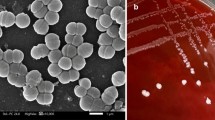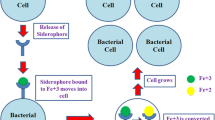Abstract
The emergence of magnetic nanotechnology has prompted the development of novel sample preparation techniques. Phytic acid (PA) is an organophosphate compound of natural origin. Not only is it highly attractive to multivalent metal ions such as calcium, zinc, and iron, but it is also capable of forming complexes with molecules such as proteins. Here, we describe a highly cost-effective method of phytic acid-modified Fe3O4 (Fe3O4-PA) for the rapid concentration and isolation of foodborne pathogens. Using three examples for Gram-negative and Gram-positive bacteria, respectively, we demonstrate the excellent selective ability of Fe3O4-PA towards Gram-positive bacteria with more than 98.76% capture efficiency for MRSA. The Fe3O4-PA trap almost completely captured Staphylococcus aureus at a concentration of about 5.82 × 103 CFU/mL in apple juice. Scanning electron microscopy and confocal laser microscopy experiments showed that Fe3O4-PA can be non-destructive and non-lethal for the enrichment of Gram-positive bacteria. We believe that our work provides a fast and promising method for concentrating bacteria directly from food.





Similar content being viewed by others
Data Availability
The authors declare that the data supporting the findings of this study are available within the article and its Supplementary Information. Extra data are available from the corresponding author upon reasonable request.
Abbreviations
- PA:
-
Phytic acid
- IMS:
-
Immunomagnetic separation
- PI:
-
Propidium iodide
- DAPI:
-
4′-6-Diamidino-2-phenylindole
- E.coli :
-
Escherichia coli
- S.typhi :
-
Salmonella typhimurium
- S.aureus:
-
Staphylococcus aureus
- C.sakazakii :
-
Cronobacter sakazakii
- LM:
-
Listeria monocytogenes
- MRSA:
-
Methicillin-resistant Staphylococcus aureus
- SEM:
-
Scanning electron microscopy
- FT-IR:
-
Infrared Fourier transform spectrometer
- XRD:
-
X-ray diffraction
- XPS:
-
X-ray photoelectron spectroscopy
- CLSM:
-
Confocal laser scanning microscope
- EMB:
-
Eosin-methylene blue
References
Beyki, M. H., Malakootikhah J., Shemirani F., & Minaeian S. (2018). Magnetic CoFe2O4@ melamine based hyper-crosslinked polymer: A multivalent dendronized nanostructure for fast bacteria capturing from real samples. Process Safety and Environmental Protection, 116, 14–21. https://doi.org/10.1016/j.psep.2018.01.009
Bloot, A. P. M., Kalschne, D. L., Amaral, J. A. S., Baraldi, I. J., & Canan, C. (2021). A review of phytic acid sources, obtention, and applications. Food Reviews International. https://doi.org/10.1080/87559129.2021.1906697
Boukhris, I., Smaoui, S., Ennouri, K., Morjene, N., Farhat-Khemakhem, A., Blibech, M., Alghamdi, O. A., & Chouayekh, H. (2020). Towards understanding the antagonistic activity of phytic acid against common foodborne bacterial pathogens using a general linear model. PLoS ONE, 15(4), e0231397. https://doi.org/10.1371/journal.pone.0231397
Cai K., Shen W., Ren B., He J., Wu S., & Wang W. (2017). A phytic acid modified CoFe2O4 magnetic adsorbent with controllable morphology, excellent selective adsorption for dyes and ultra-strong adsorption ability for metal ions. Chemical Engineering Journal, 330, 936–946. https://doi.org/10.1016/j.cej.2017.08.009
Crea F., De Stefano C., Milea D., & Sammartano S. (2008). Formation and stability of phytate complexes in solution. Coordination Chemistry Reviews, 252(10), 1108–1120. https://doi.org/10.1016/j.ccr.2007.09.008
Deng, H., Li, X., Peng, Q., Wang, X., Chen, J., & Li, Y. (2005). Monodisperse magnetic single-crystal ferrite microspheres. Angewandte Chemie, 117(18), 2842–2845. https://doi.org/10.1002/ange.200462551
Dester, E., & Alocilja, E. (2022). Current methods for extraction and concentration of foodborne bacteria with glycan-coated magnetic nanoparticles: A review. Biosensors, 12(2), 112. https://doi.org/10.3390/bios12020112
Ding S.-Y., Faraj Y., Wei J., Wang W., Xie R., Liu Z., Ju X.-J., & Chu L.-Y. (2020). Antimicrobial peptide-functionalized magnetic nanoparticles for rapid capture and removal of pathogenic bacteria. Microchemical Journal, 159, 105493. https://doi.org/10.1016/j.microc.2020.105493
Feizollahi E., Mirmahdi R. S., Zoghi A., Zijlstra R. T., Roopesh M. S., & Vasanthan T. (2021). Review of the beneficial and anti-nutritional qualities of phytic acid, and procedures for removing it from food products. Food Research International, 143, 110284. https://doi.org/10.1016/j.foodres.2021.110284
Gan, N., Qin, W., Zhang, C., & Jiao, T. (2022). One-step in situ deposition of phytic acid–metal coordination complexes for combined Porphyromonas gingivalis infection prevention and osteogenic induction. Journal of Materials Chemistry b, 10(22), 4293–4305. https://doi.org/10.1039/D2TB00446A
He X., Zhang J., Xie L., Sathishkumar G., Li C., Rao X., Zhao J., Zhang K., Wang R., Kang E.-T., & Xu L. (2022). Phytic acid-promoted rapid fabrication of natural polypeptide coatings for multifunctional applications. Chemical Engineering Journal, 440, 135917. https://doi.org/10.1016/j.cej.2022.135917
Jiang, W., Saxena, A., Song, B., Ward, B. B., Beveridge, T. J., & Myneni, S. C. B. (2004). Elucidation of functional groups on gram-positive and gram-negative bacterial surfaces using infrared spectroscopy. Langmuir, 20(26), 11433–11442. https://doi.org/10.1021/la049043+
Kim Nam, H., Rhee Min, S., & Schaffner, D. W. (2016). Phytic acid and sodium chloride show marked synergistic bactericidal effects against nonadapted and acid-adapted Escherichia coli O157:H7 strains. Applied and Environmental Microbiology, 82(4), 1040–1049. https://doi.org/10.1128/AEM.03307-15
Kumar A., Singh B., Raigond P., Sahu C., Mishra U. N., Sharma S., & Lal M. K. (2021). Phytic acid: Blessing in disguise, a prime compound required for both plant and human nutrition. Food Research International, 142, 110193. https://doi.org/10.1016/j.foodres.2021.110193
Li R., Wang X., Cai X., Lin H., Shen L., Chen J., Hong H., & Liao B.-Q. (2018). A facile strategy to prepare superhydrophilic polyvinylidene fluoride (PVDF) based membranes and the thermodynamic mechanisms underlying the improved performance. Separation and Purification Technology, 197, 271–280. https://doi.org/10.1016/j.seppur.2018.01.017
Li Y., Yu E., Sun S., Liu W., Hu R., & Xu L. (2022). Fast and highly efficient adsorption of cationic dyes by phytic acid crosslinked β-cyclodextrin. Carbohydrate Polymers, 284, 119231. https://doi.org/10.1016/j.carbpol.2022.119231
Miao C., Yang L., Wang Z., Luo W., Li H., Lv P., & Yuan Z. (2018). Lipase immobilization on amino-silane modified superparamagnetic Fe3O4 nanoparticles as biocatalyst for biodiesel production. Fuel, 224, 774–782. https://doi.org/10.1016/j.fuel.2018.02.149
Muhammad, A. I., Xiang, Q., Liao, X., Liu, D., & Ding, T. (2018). Understanding the impact of nonthermal plasma on food constituents and microstructure—A review. Food and Bioprocess Technology, 11(3), 463–486. https://doi.org/10.1007/s11947-017-2042-9
Mújica-Paz, H., Valdez-Fragoso, A., Samson, C. T., Welti-Chanes, J., & Torres, J. A. (2011). High-pressure processing technologies for the pasteurization and sterilization of foods. Food and Bioprocess Technology., 4(6), 969–985. https://doi.org/10.1007/s11947-011-0543-5
Nassar, M., Nassar, R., Maki, H., Al-Yagoob, A., Hachim, M., Senok, A., Williams, D., & Hiraishi, N. (2021). Phytic acid: Properties and potential applications in dentistry. Frontiers in Materials. https://doi.org/10.3389/fmats.2021.638909
Nassar R., & Nassar M. (2016). Antimicrobial effect of phytic acid on Enterococcus faecalis. The International Arabic Journal of Antimicrobial Agents. https://doi.org/10.3823/796
Neethirajan, S., & Jayas, D. S. (2011). Nanotechnology for the food and bioprocessing industries. Food and Bioprocess Technology, 4(1), 39–47. https://doi.org/10.1007/s11947-010-0328-2
Nunes, B. V., da Silva, C. N., Bastos, S. C., & de Souza, V. R. (2022). Microbiological inactivation by ultrasound in liquid products. Food and Bioprocess Technology, 15(10), 2185–2209. https://doi.org/10.1007/s11947-022-02818-z
Peng, B., Zhang, X., Aarts, D., & Dullens, R. P. A. (2018). Superparamagnetic nickel colloidal nanocrystal clusters with antibacterial activity and bacteria binding ability. Nature Nanotechnology, 13(6), 478–482. https://doi.org/10.1038/s41565-018-0108-0
Sande, M. G., Çaykara, T., Silva, C. J., & Rodrigues, L. R. (2020). New solutions to capture and enrich bacteria from complex samples. Medical Microbiology and Immunology, 209(3), 335–341. https://doi.org/10.1007/s00430-020-00659-1
Wang L., & Lin J. (2020). Recent advances on magnetic nanobead based biosensors: From separation to detection. TrAC Trends in Analytical Chemistry, 128, 115915. https://doi.org/10.1016/j.trac.2020.115915
Wang R., & Guo S. (2021). Phytic acid and its interactions: Contributions to protein functionality, food processing, and safety. Comprehensive Reviews in Food Science and Food Safety, 20(2), 2081–2105. https://doi.org/10.1111/1541-4337.12714
Yan, C., Wang, C., Hou, T., Guan, P., Qiao, Y., Guo, L., Teng, Y., Hu, X., & Wu, H. (2021). Lasting tracking and rapid discrimination of live gram-positive bacteria by peptidoglycan-targeting carbon quantum dots. ACS Applied Materials & Interfaces, 13(1), 1277–1287. https://doi.org/10.1021/acsami.0c19651
Yew Y. P., Shameli K., Miyake M., Ahmad Khairudin N. B. B., Mohamad S. E. B., Naiki T., & Lee K. X. (2020). Green biosynthesis of superparamagnetic magnetite Fe3O4 nanoparticles and biomedical applications in targeted anticancer drug delivery system: A review. Arabian Journal of Chemistry, 13(1), 2287–2308. https://doi.org/10.1016/j.arabjc.2018.04.013
Yue T., Guo C., Yuan Y., Wang Z., Luo Y., & Wang L. (2013). Adsorptive removal of patulin from apple juice using Ca-alginate-activated carbon beads. Journal of Food Science, 78(10), T1629–T1635. https://doi.org/10.1111/1750-3841.12254
Zhou, Q., Zhao, Y., Dang, H., Tang Y., & Zhang B. (2019). Antibacterial effects of phytic acid against foodborne pathogens and investigation of its mode of action. Journal of Food Protection, 82(5), 826–833. https://doi.org/10.4315/0362-028X.JFP-18-418%JJournalofFoodProtection
Acknowledgements
The authors would like to thank the instrument shared platform of college of Food science & Engineering and State Key Laboratory of Crop Stress Biology for Arid Areas of Northwest A&F University, for the assistance in the FITR, SEM and optical properties analysis.
Funding
The authors thank the National Science Foundation of China (31901794), the National Postdoctoral Program for Innovative Talents (BX20180263), the Young Talent Fund of University Association for Science and Technology in Shaanxi, China (2019–02–03), the Key Research and Development Program of Shaanxi Province (2022NY-001), and the Tang Scholar by Cyrus Tang Foundation.
Author information
Authors and Affiliations
Contributions
Yi Kang: methodology, writing—original draft. Hao Sun, Yanmin Liang, Jie Dan, Qiuping Zhang, and Zehui Su: investigation. Jianlong Wang: supervision. Wentao Zhang: writing-reviewing and editing, conceptualization, funding acquisition.
Corresponding author
Ethics declarations
Conflict of Interest
The authors declare no competing interests.
Additional information
Publisher's Note
Springer Nature remains neutral with regard to jurisdictional claims in published maps and institutional affiliations.
Supplementary Information
Below is the link to the electronic supplementary material.
Rights and permissions
Springer Nature or its licensor (e.g. a society or other partner) holds exclusive rights to this article under a publishing agreement with the author(s) or other rightsholder(s); author self-archiving of the accepted manuscript version of this article is solely governed by the terms of such publishing agreement and applicable law.
About this article
Cite this article
Kang, Y., Liang, Y., Sun, H. et al. Selective Enrichment of Gram-positive Bacteria from Apple Juice by Magnetic Fe3O4 Nanoparticles Modified with Phytic Acid. Food Bioprocess Technol 16, 1280–1291 (2023). https://doi.org/10.1007/s11947-022-02984-0
Received:
Accepted:
Published:
Issue Date:
DOI: https://doi.org/10.1007/s11947-022-02984-0




